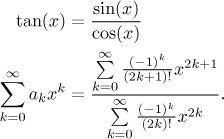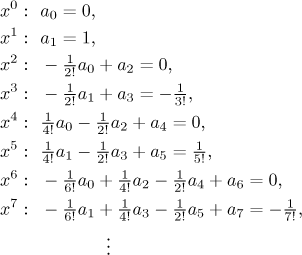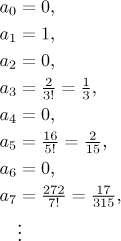Problem: Expand the given function in a power (Taylor) series with the given center:
![]()
Solution: The arctangent is not a function whose series we would remember. Thus we need to find come connection between this function and the quartet that we do remember. There is no way to get arctangent using some algebraic operations from the four functions. One possibility is to use the Lagrange inverse formula applied to arctangent as the inverse function to tangent. However, that would be really bad (see below), so we will leave this as the last resort.
How about other means of linking functions, for instance differentiation.
The derivative of arctangent is
![]()
Now we use the geometric expansion, note that it is valid only for

To get to arctangent we need to integrate. There are two possibilities. One is to integrate using a definite integral with variable as the upper limit (then it is good to change the variable in our expansion to t), which yields

The other alternative is to use indefinite integral.

We need to determine C, but that is quite simple. The above equality
is supposed to be true for all x with
Remark: How would it go using the Lagrange inversion formula? In our case it goes

The derivative of general order

This seems to fit our result above but to go any further is a waste of time, already the second derivative was quite ugly.
Bonus: Here we show how to expand tangent using the fact that it is a ratio of two functions with known expansions, that is, we use the method of undetermined coefficients. We start by setting up the standard equation for tangent and then replace all functions involved in it by their series. Since we do not know the right series for tangent yet, we just put a general power series with center 0 there.

Now we multiply by the denominator and then we rewrite the series in their long way so that we see better what is going on.

When we use the Cauchy multiplication on the left, we will see what the coefficients are at concrete powers xk, which can be compared with the corresponding coefficients on the right. We get the equations

The pattern seems clear. Inductively we determine

Do we see any pattern? Actually, no. In fact the Taylor series for tangent is known, but its coefficients use something called the Bernoulli constant that is definitely not easy to evaluate (and frankly, with what we covered here in Math Tutor we have no chance of actually getting to it). At least the method of undetermined coefficients allowed us to find the beginning of the expansion for tangent,
![]()